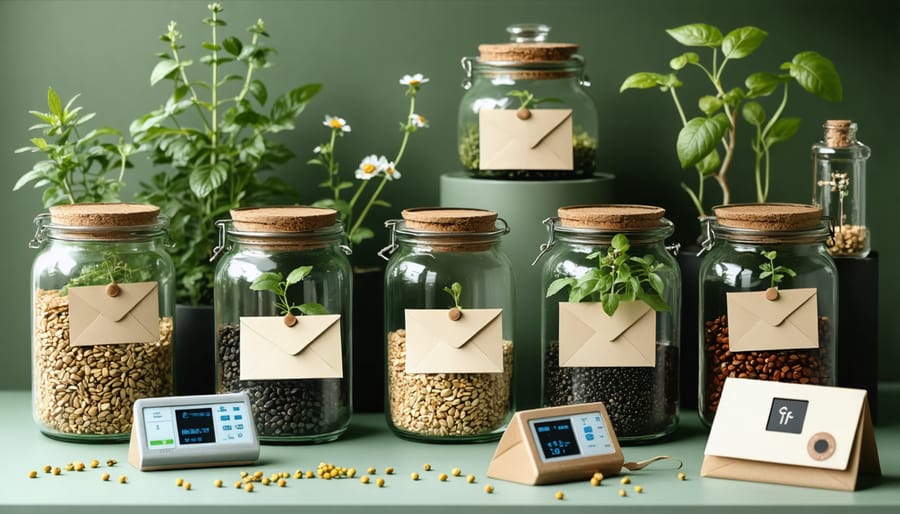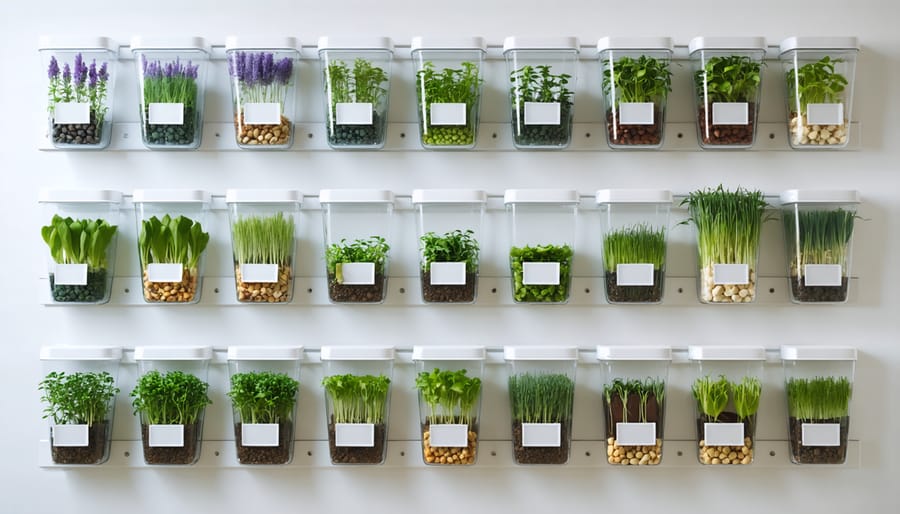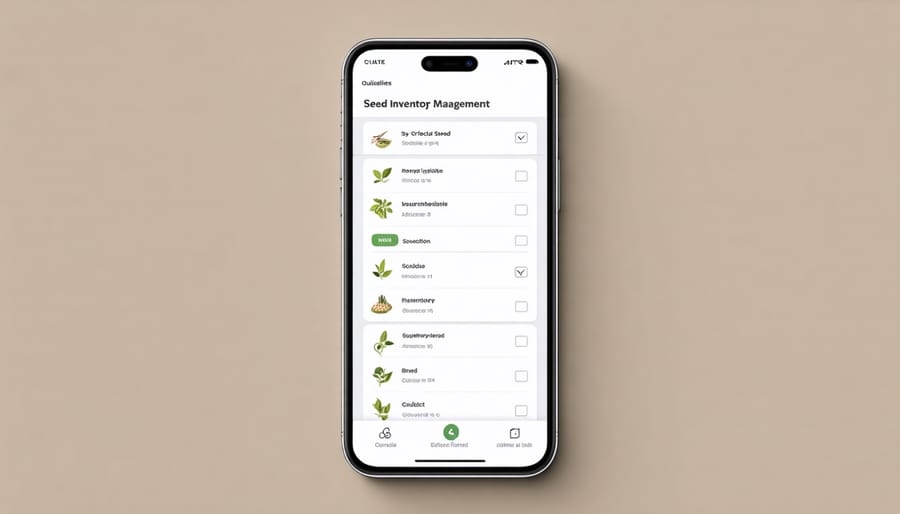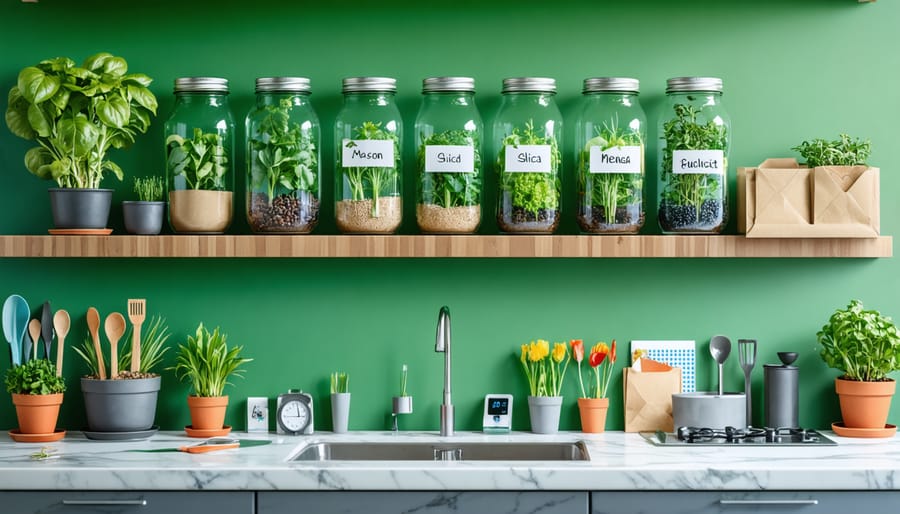Transform your kitchen into a seed-saving sanctuary using airtight mason jars with silica gel packets to maintain optimal moisture levels. Store precious heirloom varieties in labeled paper envelopes within these jars, organizing them by planting season and family type. Maximize limited urban space by repurposing photo albums into seed storage books, with clear pocket pages protecting individual seed varieties while keeping them visible and accessible. Understanding proper seed saving practices ensures your carefully collected seeds remain viable for years, creating a sustainable cycle of growth for your urban garden. Monitor temperature and humidity using affordable digital meters, maintaining the ideal storage environment between 32-41°F (0-5°C) and relative humidity below 50%. This systematic approach to seed storage not only preserves genetic diversity but also empowers you to cultivate a self-sustaining garden, regardless of your living space constraints.
Understanding Seed Storage Basics

Temperature and Humidity Control
Temperature and humidity are crucial factors in maintaining seed viability. The ideal storage temperature for most seeds ranges between 32-41°F (0-5°C), with relative humidity levels kept below 40%. Think of your seeds like sleeping beauties – they need the right conditions to stay dormant yet alive until planting time.
A dedicated spot in your refrigerator works perfectly for home seed storage, but be sure to use moisture-proof containers with desiccant packets to control humidity. For those without refrigerator space, a cool basement or cellar can serve as an alternative, though seeds may not last quite as long.
Monitor your storage area with a simple thermometer and humidity gauge to ensure conditions remain stable. Remember that temperature fluctuations can be just as harmful as constant high temperatures. Each 10-degree rise in temperature and 1% increase in seed moisture can cut storage life in half, so consistency is key to maintaining your seed collection’s viability.
Light and Air Exposure
Light and air exposure are two critical factors that can make or break your seed storage success. Seeds naturally want to grow when exposed to light and oxygen, which triggers their germination process. To maintain dormancy and preserve viability, store your seeds in complete darkness. Even brief exposure to sunlight can reduce their longevity and germination rates.
Oxygen exposure accelerates seed aging and can attract unwanted moisture. That’s why many experienced gardeners use airtight containers with oxygen absorbers for long-term storage. A clever tip from urban farmer Sarah Chen is to store seeds in small, opaque paper envelopes before placing them in your main storage container. This provides an extra layer of protection against light while allowing you to organize different varieties easily.
Remember to minimize how often you open your storage containers, as each opening introduces fresh air and light. Consider dividing your seed collection into frequently used and long-term storage portions to reduce exposure to these elements.
Space-Saving Storage Solutions
Vertical Storage Systems
Vertical storage solutions are a game-changer for urban gardeners and seed savers working with limited space. Wall-mounted organizers, like repurposed shoe organizers with clear pockets, make perfect seed libraries while keeping your precious seeds visible and easily accessible. These hanging systems protect seeds from direct sunlight while maximizing vertical space.
Consider installing a pegboard wall system with adjustable hooks and small containers – it’s not only practical but adds a decorative element to your gardening space. Magnetic strips mounted on walls can hold small metal containers filled with seeds, creating an attractive and functional display.
For a sustainable approach, try using recycled mason jars arranged on floating shelves. These airtight containers protect seeds from moisture while showcasing your collection beautifully. Hanging pocket organizers made from breathable fabric work wonderfully for storing seed packets, and they can be easily rolled up when not in use.
Remember to label everything clearly and keep your vertical storage away from heat sources and direct sunlight to maintain seed viability. This approach not only saves space but also keeps your seeds organized and within easy reach during planting season.

Compact Organization Methods
When space is at a premium, smart organization can make all the difference in seed storage. One popular method is using clear photo organizers, which feature multiple small compartments perfect for separating different seed varieties while taking up minimal shelf space. Small spice jars or mini mason jars can be mounted on walls using magnetic strips, creating an accessible and attractive storage solution.
For those with extensive collections, tackle boxes or craft organizers work wonderfully, offering adjustable compartments and easy portability. Paper coin envelopes stored vertically in index card boxes provide an economical solution that maximizes vertical space while protecting seeds from moisture.
Consider using hanging shoe organizers with clear pockets – they can be mounted on the back of a door or wall, turning unused vertical space into organized seed storage. For tiny spaces, repurposed pill organizers or contact lens cases work perfectly for storing small quantities of seeds.
Label everything clearly with seed type, variety, and date, and group similar plants together for easy access during planting season. These compact solutions help maintain seed viability while keeping your collection neat and accessible.
DIY Storage Containers
Upcycled Container Ideas
Give your seed collection a sustainable home by repurposing everyday items from around your house. Clean glass jars from pasta sauce, pickles, or jams make excellent seed storage containers – just be sure to thoroughly wash and dry them first. Small mint tins or metal cookie boxes work wonderfully for storing smaller seed varieties, while offering protection from light and moisture.
Paper envelopes from mail can be transformed into perfect seed packets – simply turn them inside out, clean them up, and relabel. Old pill bottles, once properly sanitized, are ideal for storing tiny seeds like lettuce or carrots, and their childproof caps provide extra security.
For larger seed collections, consider using cleaned-out spice containers with shaker tops, which make dispensing seeds easier during planting season. Empty tea tins offer both style and function, especially those with hinged lids. Mason jars with their two-piece lids are particularly effective, as they create an airtight seal that keeps seeds fresh longer.
Remember to label each container clearly with the seed variety and date of storage. Adding a small packet of silica gel (saved from vitamin bottles or shoe boxes) helps control moisture.
Moisture-Control Solutions
Controlling moisture is crucial for maintaining seed viability, and there are several effective DIY solutions that won’t break the bank. The simplest method is using silica gel packets – those little sachets you find in shoe boxes and electronics. Save these packets and add them to your seed storage containers. For a natural alternative, raw rice works wonderfully as a desiccant; simply fill small fabric pouches with rice and place them in your storage containers.
Another tried-and-true method is using powdered milk. Place two tablespoons of powder in a paper tissue, fold it carefully, and secure with a rubber band. These homemade desiccant packets last about six months before needing replacement. For larger storage containers, clay desiccants like bentonite can be effective – just place a small amount in a breathable fabric pouch.
Monitor humidity levels by including a paper strip in your storage containers. If it feels crisp, the moisture level is good. If it feels soft or limp, add more desiccant. Remember to check your moisture-control materials every few months and replace them as needed to maintain optimal storage conditions.
Organization and Labeling Systems
Digital Tracking Methods
In today’s digital age, keeping track of your seed collection has never been easier. Modern digital seed management systems offer convenient ways to maintain detailed records of your seeds. Popular apps like Gardenize and Planta let you catalog varieties, track planting dates, and set reminders for seed viability testing. Many gardeners use simple spreadsheet templates to monitor their inventory, while others prefer dedicated garden planning apps that include seed storage features.
Cloud-based solutions ensure your records are safe and accessible from any device. These digital tools often include helpful features like germination rate tracking, photos of seed varieties, and notes about successful growing conditions. Some apps even connect you with local seed-sharing communities, making it easier to exchange heritage varieties and maintain biodiversity in your garden. Whether you’re a casual gardener or serious seed saver, digital tracking helps maintain an organized and effective seed storage system.

Physical Organization Tips
Implement a clear labeling system using waterproof labels or tags that include essential information like seed variety, harvest date, and expected viability period. Create categorized storage zones based on plant families or growing seasons to streamline your planting schedule. Small manila envelopes work perfectly for organizing individual seed varieties, while index card boxes can house these envelopes in alphabetical order.
Consider using a color-coding system – for example, green labels for leafy vegetables, yellow for summer crops, and orange for fall plantings. Keep a detailed inventory log, either in a dedicated notebook or digital spreadsheet, to track your seed collection and planting history.
For easy access, arrange seeds by planting dates, keeping spring varieties at the front of your storage system. Small plastic organizers with adjustable compartments work well for storing multiple seed packets while maximizing space efficiency. Remember to include silica gel packets in each storage container to maintain optimal moisture levels.
Proper seed storage is not just about preserving next season’s garden – it’s about securing our future food systems and helping to maintain seed diversity for generations to come. Whether you’re using mason jars, paper envelopes, or repurposed containers, the key is creating a cool, dry, and dark environment that protects your seeds’ vitality. Remember to label everything clearly with the variety name and date, and check your stored seeds periodically for any signs of moisture or pest activity.
By implementing these storage methods, you’re not only saving money on future seed purchases but also becoming part of a larger movement toward sustainable gardening practices. Start small, experiment with different storage solutions, and adapt them to your space and climate. As your seed collection grows, so will your confidence in seed saving and storage techniques.
Together, we can create a more resilient and sustainable food system, one carefully stored seed at a time. Happy seed saving!

